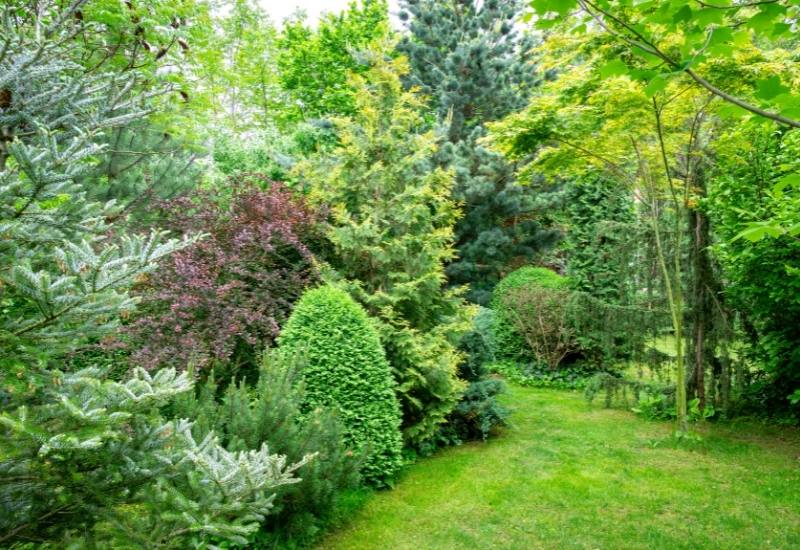
Fine, you cannot landscape your small garden with a baobab or with a massive cedar tree, but there are many dwarf varieties of certain trees will allow you to dress up your cramped garden space, for example a small city garden in the most beautiful way.
With evergreen and deciduous, flowering and fruiting species, your green space can be as beautiful as any large park, just in a smaller scale! In addition to their small size, miniature trees require less maintenance and yet offer a warm appearance and add a little privacy to your front or backyard landscape.
Growing to about 10 to 15 feet tall, dwarf ornamental trees can fit into modest spaces and even into containers on your balcony. This means that you can even grow exotic specimens in cold regions, and grow them on your terrace or patio space.
Just read our great selection of small and dwarf trees and you will see that you can even have a miniature and varied forest even if your garden is not large at all.
We have chosen small trees of many types and with very different looks, from exotic to temperate, so, whichever your landscaping style, one of these will be good for you.
15 Stunning Dwarf Ornamental Trees For Small Yard Landscaping
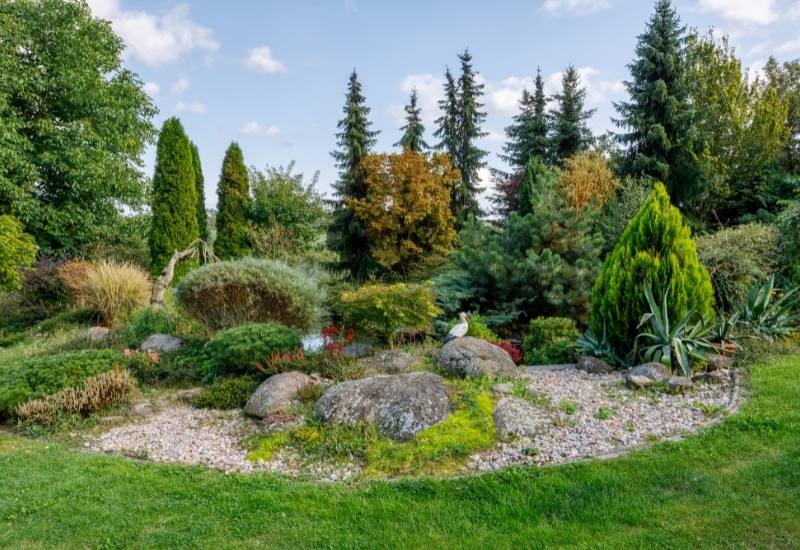
When choosing the best trees for small gardens, opt for the one that will best meet your expectations based on its size, maintenance and desired aesthetics.
Discover our selection of 15 our favorite dwarf trees, perfectly suited to garden landscape, city gardens or to plant near a house!
1: ‘Archer’s Dwarf’ White Fir (Abies concolor ‘Archer’s Dwarf’)
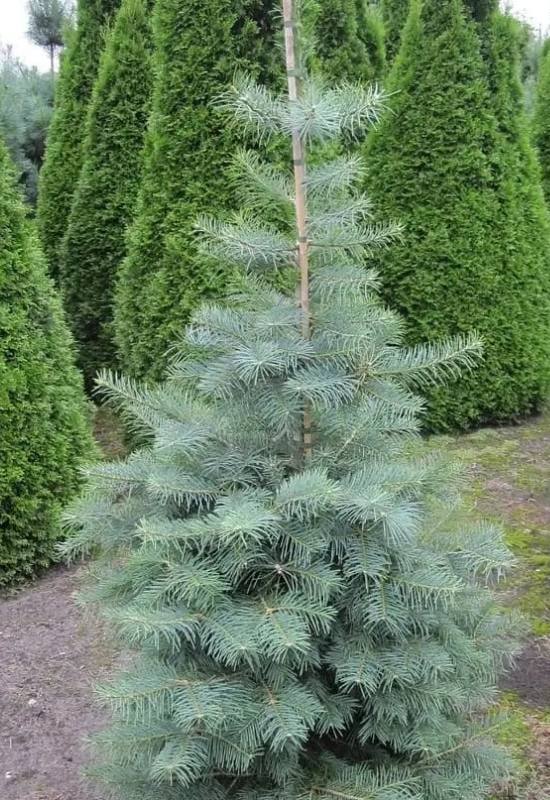
We can start with a very small but classic looking evergreen tree, for a northern or mountain inspired landscape: ‘Archer’s Dwarf’ white fir.
This tiny conifer will never grow taller than 6 feet (1.8 meters), but in that small stature it packs all the beauty of its bigger sisters.
With a lovely conical habit, it has slightly ascending branches and upturned blue green needles. It will grow very slowly, so much so that you can even fit it into a border if you wish.
It is compact and it has dense foliage starting very low, close to the ground. The cones are a beauty to behold, small and growing in clusters in the branches, they are of a very deep and decided purple color!
‘Archer’s Dwarf’ white fir has so much to offer for a small garden: unusual and strong colors, architectural shape, thick foliage all year round and… it is low maintenance as well!
2: European Fan Palm (Chamaerops humils)
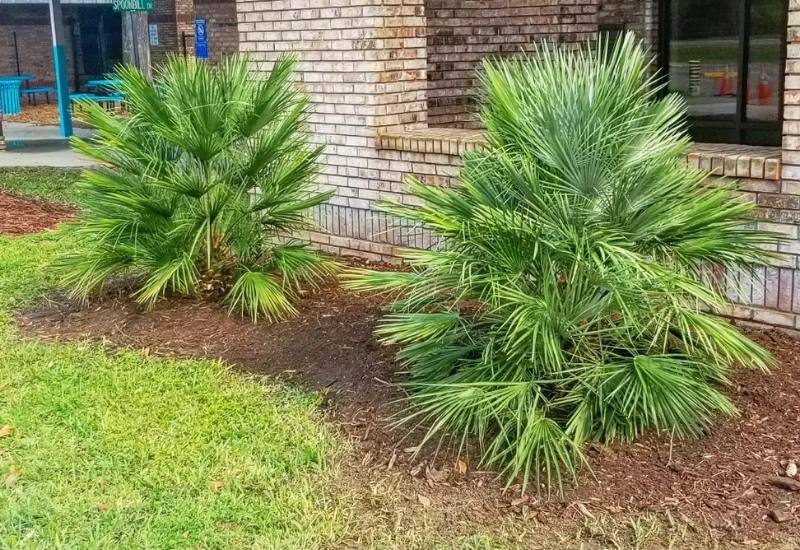
You can have a tropical landscape even in a small garden if you pick European fan palm. Growing to 6 or 15 meters (1.8 to 4.5 meters), this cycad has all the personality of a Caribbean tree, though it comes from the Mediterranean.
The large fronds are fan shaped, with blade like leaflets, dense and blue or silver green in color, reaching 4 feet long (120 cm), with spiked petioles.
The trunks are upright, scaly and brown in color. It will also give you clusters of yellow flowers in spring, growing at the base of the foliage.
Then, the blooms will turn into yellow orange round fruits that will ripen to a warm and glossy brown shade later on.
While European fan palm can spread with multi stems, you can keep it narrow by pruning all the suckers that grow at the base of the stem and keep it in the classical shape you see on exotic postcards. Maybe for this reason it has won the Award of Garden Merit by the Royal Horticultural Society.
3: Myer’s Lemon (Citrus x limon ‘Meyer’)
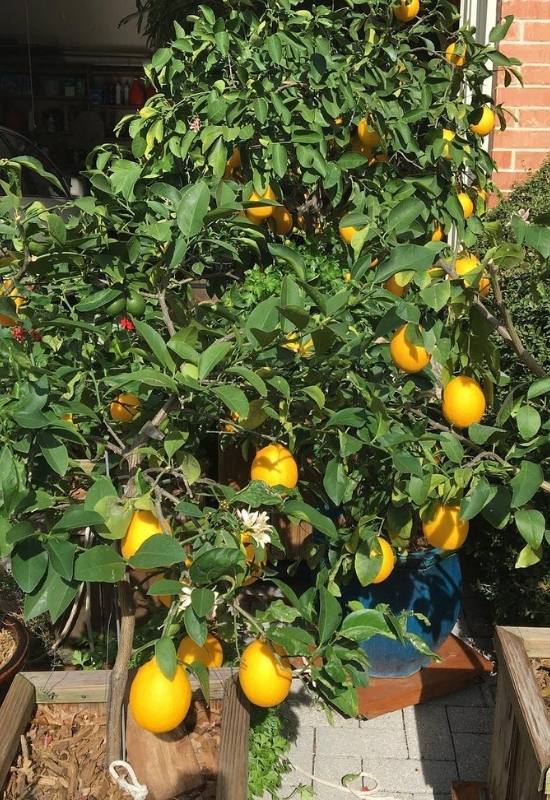
You cannot miss out on a citrus lemon tree in a Mediterranean landscape garden, and Meyer’s lemon will fit a small one, as it will only reach 6 to 10 feet tall (1.8 to 3.0 meters).
But compact varieties will still produce fragrant and juicy orange yellow fruits, that you can eat, and they are sweeter than usual lemons, with an aftertaste of tangerine.
And you also get aromatic white flowers too! The evergreen leaves are glossy and light to mid green, elliptical and refreshing to look at.
This dwarf variety is really perfect for containers, so it can spend its winter dormancy in a warm place if you live in a cold region.
Winner of the Award of Garden Merit by the Royal Horticultural Society, Myer’s lemon is also a strong and healthy plant; in fact it was bread to withstand viruses that attack lemon trees. Ideal for sunlit terraces as well as gardens.
4: Dwarf Apple (Malus domestica)
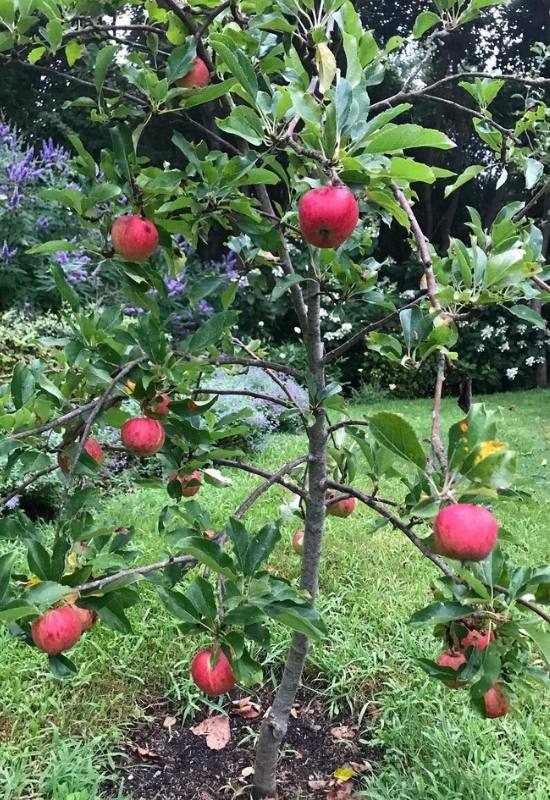
Bring juicy red fruits to your green landscape, even if small, thanks to dwarf apple varieties.
There are many dwarf cultivars, in fact, that never grow taller than 8 feet (2.4 meters) and they can even fit on a terrace.
They will still give you lovely white or white and pink blooms in spring, with a huge display for a little tree.
And then, of course, you will get the apples themselves, that ripen to different shades of red depending on the cultivar, but they are all delicious.
The upright trunk will spread to upward turning branches that grow mid green, broad leaves for a country life effect from late spring all the way to fall.
Dwarf apple varieties can grow well in containers as well as in the ground; for a natural looking, countryside inspired landscape on a small scale, they are just perfect – and useful too!
5: Magnolia ‘Susan’ (Magnolia ‘Susan’)
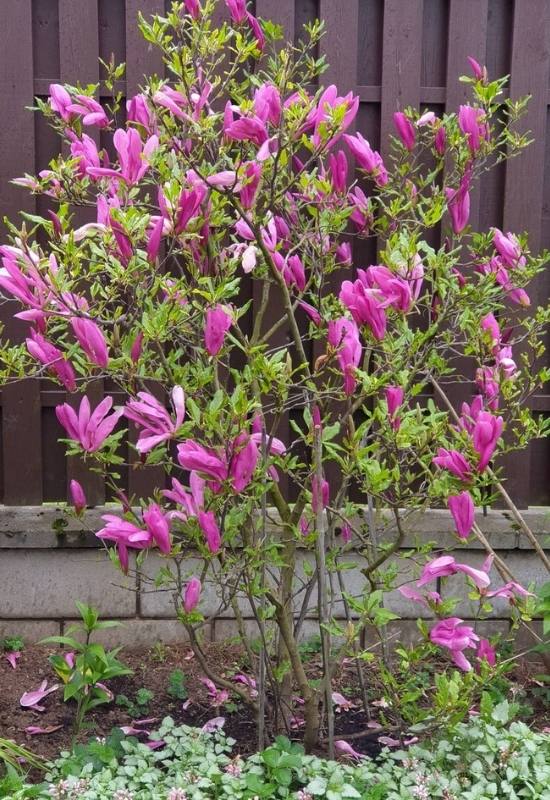
How about a small tree with massive flowers to landscape your garden? Magnolia ‘Susan’ gives you all this.
Within the 8 to 12 feet of its height (2.4 to 3.6 meters), this dwarf flowering tree can give you displays like very few other flowering species can.
The blooms are large, up to 5 inches across (12 cm), with twisted petals, very fragrant and plentiful on the branches.
They are purple red outside and of a lighter shade of the same color inside. While the main blossom will come in spring, it can even give you smaller ones later in the season if you keep the soil humid. The broad, glossy mid green foliage will then turn yellow in the fall, for a final explosion of light!
Magnolia ‘Susan’ is by far one of the best small varieties available; it is also very cold hardy, suitable for containers and, rightly, it has won the Award of Garden Merit by the Royal Horticultural Society.
6: ‘Mops’ Dwarf Mountain Pine (Pinus mugo ‘Mops’)
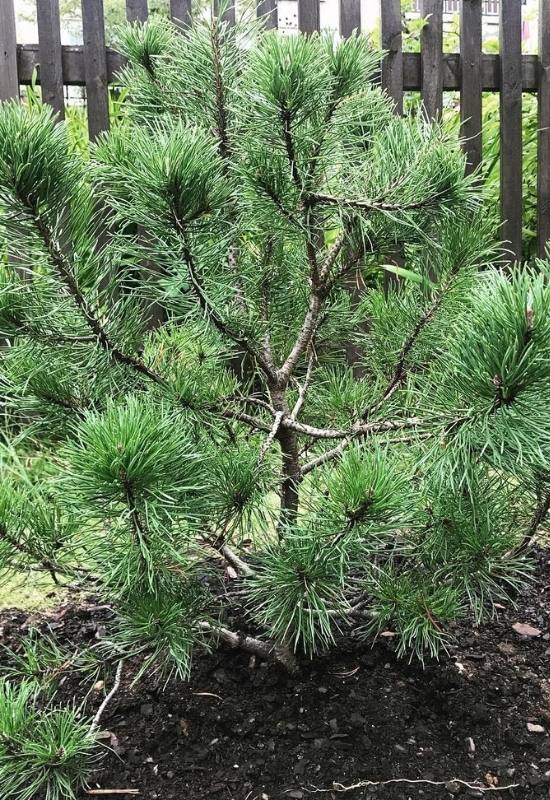
‘Mops’ dwarf mountain pine has excellent sculptural qualities, despite its diminutive size of only up to 4 feet tall (120 cm)!
This tiny conifer forms a round cushion of green needles at the top, which makes it very attractive, soft looking and geometrically interesting.
And in winter, it will offer you a very interesting twist, when its foliage takes on a yellow glow. It can be multi-trunked or single, and you can train it into interesting shapes, or even make it into a bonsai! The cones are tiny, oval and they have a mellow purple shade.
‘Mops’ is a very small mountain pine, or mugo pine, winner of the Award of Garden Merit by the Royal Horticultural Society.
It is low maintenance, cold hardy, suitable for many landscaping styles, including urban, gravel and Japanese gardens.
7: ‘Beni-Maiko’ Japanese Maple (Acer palmatum ‘Beni-Maiko’)
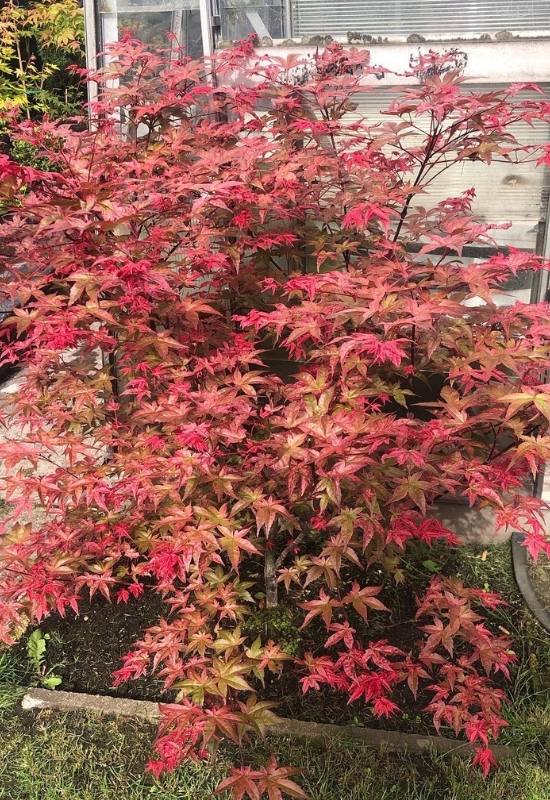
Japanese maples are compact, small and they have wonderful foliage, and you can pick from many small varieties for landscaping, but first have a look at ‘Beni-Maiko’.
With lovely palmate leaves that give you a wonderful texture, Beni-Maiko is one of the smallest cultivars of Japanese maple, reaching 4 to 6 feet tall (1.2 to 1.8 meters).
But its striking feature is that the leaves are an ever changing spectacle of colors! When they emerge in spring, they are bright red; then they turn pink green during the summer months, and, finally, they turn green with red veins as the cold season approaches.
Add the beautiful layered and gently arching branches and you get a very elegant small tree with great decorative value.
‘Beni-Mako’ Japanese maple is a winner of the Award of Garden Merit by the Royal Horticultural Society and it is perfect for oriental style gardens; however, if you have an urban, suburban or even traditional design, it will be perfectly fine as well.
8: Pigmy Date Palm (Phoenix roebelenii)
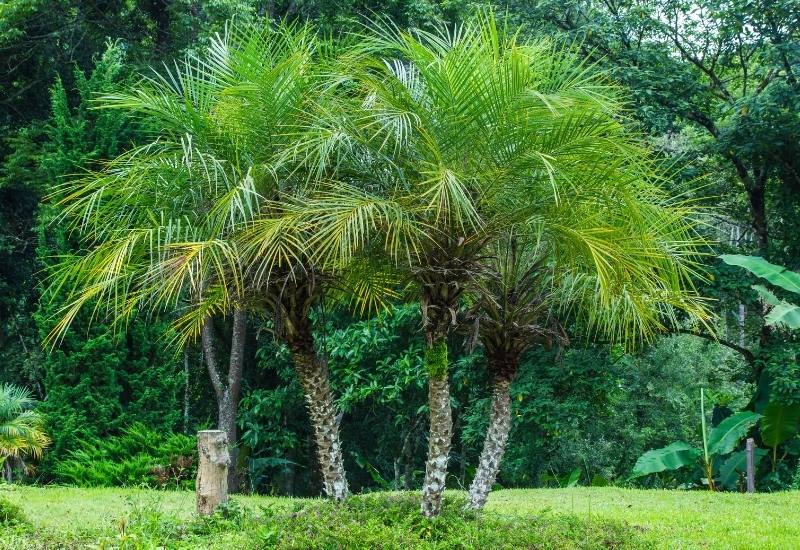
Thinking about a miniature tropical island landscape, pigmy date palm is just perfect. With a height of only 6 to 10 feet (1.8 to 3.0 meters), this dwarf dwarf tree is ideal for small gardens, and sunny poolside.
The fronds are bright green, thinly segmented and arching beautifully to a length of 3 feet 90 cm). They come on top of slender and elegant trunks, usually one, but sometimes multiple, with a diamond shaped pattern on them.
In spring you will also see lovely cream white flowers on female specimens, and these will turn into clusters of shiny red fruits that ripen to black as the season turns to a close. This compact palm has won the Award of Garden Merit by the Royal Horticultural Society for its landscaping value.
The small size of pigmy date palm makes it ideal for containers as well; because this cycad is not cold hardy, this means that you can shelter it in winter and grow it even in a temperate garden.
9: ‘J.W. Daisy’s White’ Spruce (Picea glauca var. albertiana ‘J.W. Daisy’s White’)
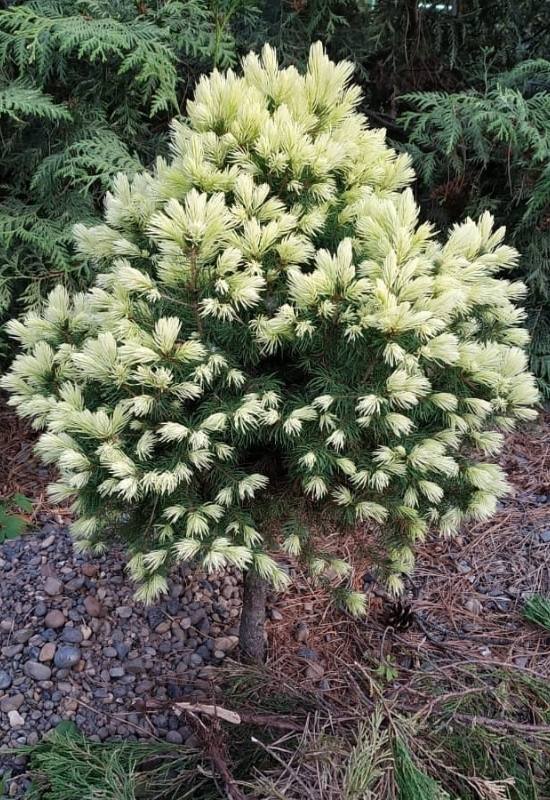
For landscaping on a really diminutive scale, ‘J.W. Daisy’s White’ spruce is really ideal thanks to its really dwarf size: only 1 to 2 feet tall (30 to 60 cm)!
But don’t be deceived, while this conifer is minute, it is also very decorative. This cone shaped dwarf evergreen tree takes its name from the cream white to pale green new shoots that cover it in spring, and give it a wonderful soft and bright look.
Short and tender, the needles form a dense canopy on the tightly packed branches that grow slightly upward.
It is also a super slow grower, which is ideal for a constant effect throughout the years. It has also won the Award of Garden Merit by the Royal Horticultural Society.
‘J.W. Daisy’s White’ spruce is ideal for containers and rock gardens, but you can grow it in gardens even in very cold regions, because it is very hardy indeed.
10: ‘Romeo’ Dwarf Cherry (Prunus fructosa x prunus cerasus ‘Romeo’)
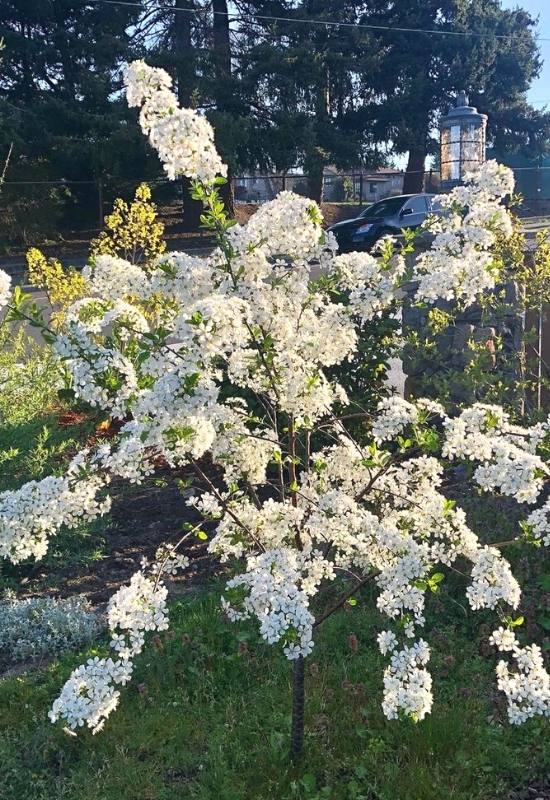
Tiny but show stopping when in bloom, ‘Romeo’ dwarf cherry is a very little tree with a big, big personality. For a small natural, country, traditional or cottage garden landscape, in fact, it is a great asset.
Growing to no more than 8 feet (2.4 meters), it packs in a massive cherry blossom of white flowers each spring like its bigger relatives.
Then of course, you also get the dark red fruits that ripen in early summer, and they are actually a very prized variety for their sweet flavor and juiciness.
The green foliage will start after pollination and it will keep on the branches till late in the fall, giving you a fresh look throughout the warm season.
‘Romeo’ dwarf cherry is also ideal for containers, thanks to its small size, but remember that it is very cold hardy, so you can easily plant it in your garden even if you live in Canada.
11: Dwarf Pomegranate (Punica granatum var. nana)
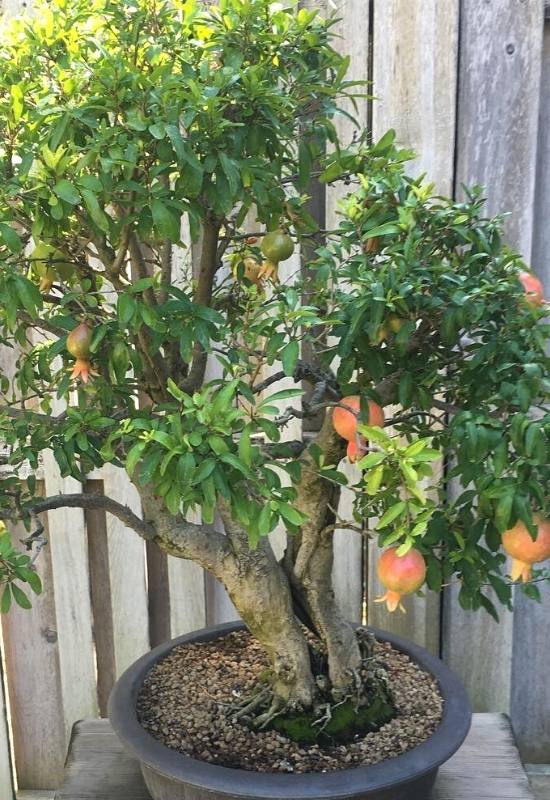
Petite but florid and full of bright colors, dwarf pomegranate will never grow taller than 4 feet (120 cm); plant it in any small garden or balcony for landscaping, but also for its juicy fruits.
Don’t forget the waxy, funnel shaped orange red flowers that fill its branches in summer! They are quite big for a small tree, about 1.5 inches (4.0 cm) and then they will turn into the round, leathery fruits that ripen to a brown red color in the fall.
These are modest in size, about 2 inches across, or 5.0 cm, but they are still delicious! The fine, glossy and bright green foliage is deciduous, thick in the branches and it starts off as bronze every spring.
Dwarf pomegranate is ideal for Mediterranean or Arabic inspired gardens and terraces, as you can also grow it in containers, but even in urban, gravel and coastal gardens it is a very valuable small tree for color and interest.
12: ‘Ebony Flame’ Crape Myrtle (Lagerstroemia ‘Ebony Flame’)
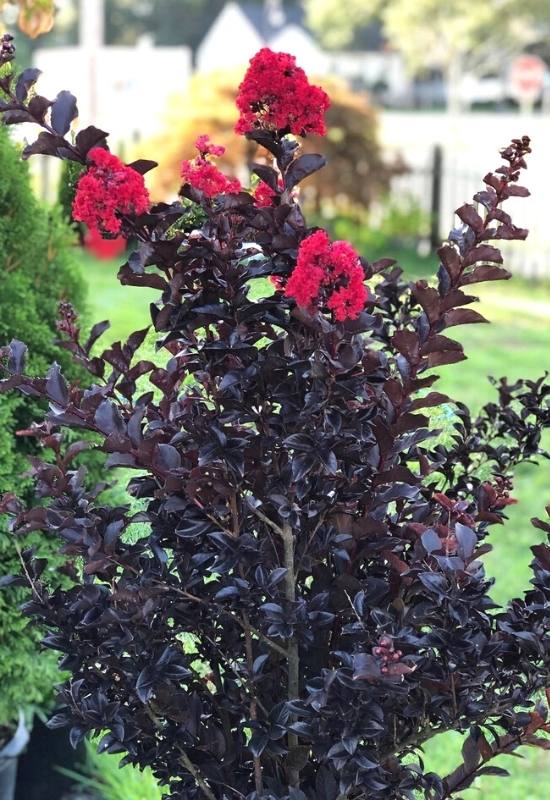
To give your garden a dramatic touch with a small tree, ‘Ebony Flame’ crape myrtle is hard to beat… With a maximum height of 12 feet (3.6 meters) but easy to prune to even smaller sizes, this variety will still become a great protagonist in your green space.
The thick foliage has a very dark shade of burgundy which will look black from a distance.
This alone sets it apart from other plants…
But throughout summer and fall, it will add a contrasting accent with its plentiful bright red flowers that come at the tips of the very dark branches.
It is deciduous, so, the foliage will drop by winter, but still the deep purple branching will provide interest even when the plant is bare.
‘Ebony Flame’ is not just one of the smallest crape myrtle varieties available, it is also one of the most unusual and striking.
This purple leafed tree is ideal for all informal gardens, even modest in size, and terraces if you grow it in containers. Just train it into a tree when it is young to avoid it turning bushy.
13: ‘Ruby Falls’ Redbud (Cercis canadensis ‘Ruby Falls’)
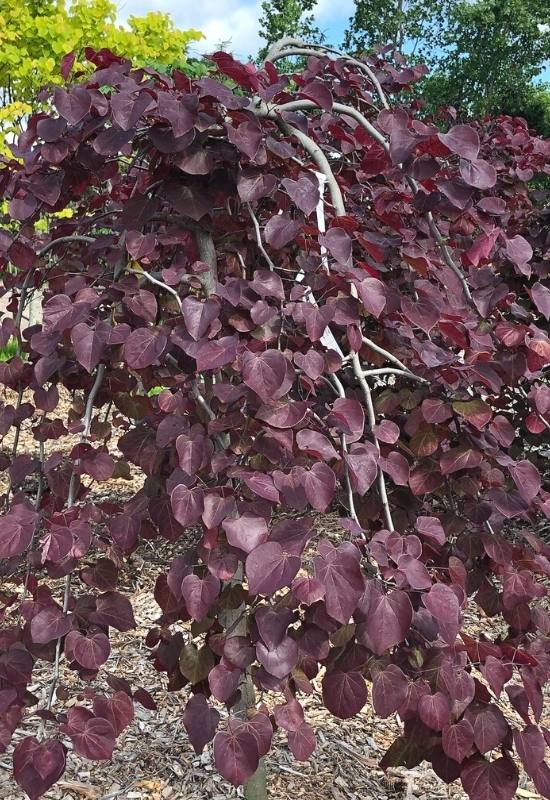
A dwarf weeping tree with amazing reddish-purple foliage color, ‘Ruby Falls’ redbud adds a unique, intense touch to your landscaping.
This dwarf cultivar of eastern redbud tree will grow to between 5 and 6 feet tall (1.5 to 1.8 meters) when adult, and its drooping thin branches will carry large, heart shaped leaves down to almost ground level.
But what really makes it unique is their color: it ranges from deep green to dark burgundy purple, even maroon, according to the season and light exposure.
In spring, it will also give you a huge display of bright magenta flowers that cover the whole plant, and it will last for about 3 weeks.
This colorful cultivar is a spectacle from spring to late fall, and it has won the Award of Garden Merit by the Royal Horticultural Society.
Grow ‘Ruby Falls’ redbud as a specimen plant in any informal garden style; from urban to cottage, it is such a valuable dwarf tree that it is hard to match. The only downside is that it is quite expensive.
14: Dwarf Key Lime Tree (Citrus x aurantifolia)
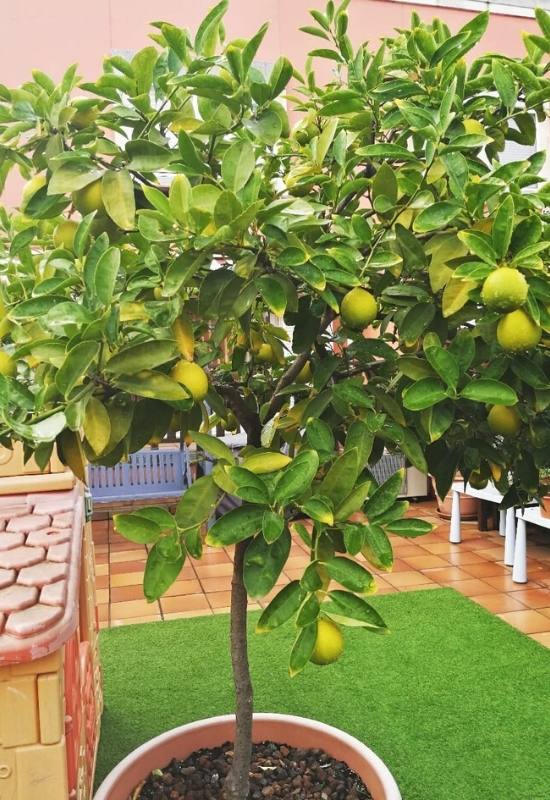
Dwarf key lime, also called Mexican or Indian lime, is just perfect to landscape a Mediterranean, Hispanic or Arabic style garden or terrace, or just to have a minute fruit tree that grows only to 4 or 6 feet tall (1.2 to 1.8 meters).
It has deep green leaves which are glossy, dense in the short branches and elliptical in shape. The crown has a round and thick habit, and it fills with fragrant white flowers spring.
The acidic but juicy fruits will follow in late spring to early summer, and they will look big on this small variety.
It will not produce any for the first year, but you it will reach full production for your kitchen by the third year of its life.
Dwarf key lime is a fresh, fragrant and vibrant presence in gardens but also on terraces. Grown in a container, in fact, you can have it even in colder climates, and surprise your visitors with an amazing small tree that you shelter in winter.
15: ‘Dwarf Cavendish’ Banana Plant (Musa acuminata ‘Dwarf Cavendish’)
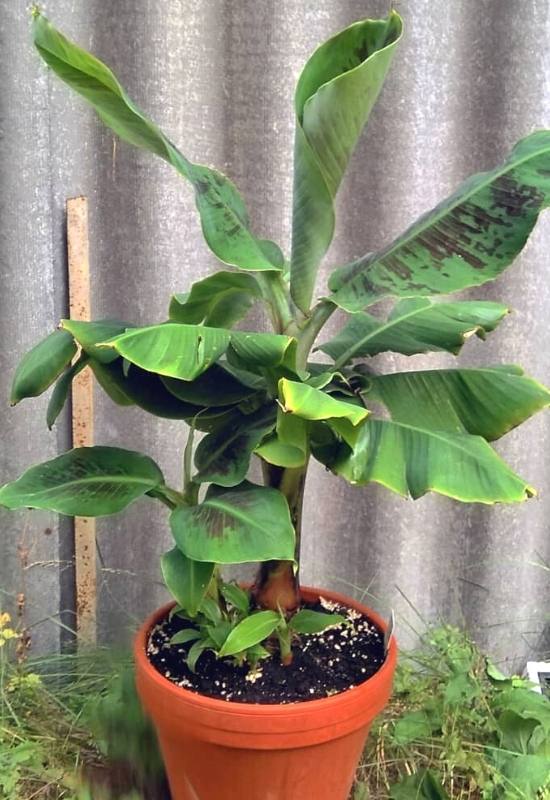
It’s true, banana plants are not technically trees, but for landscaping purposes they are treated as such, and, with its 6 to 10 feet tall (1.8 to 3.0 meters) ‘Dwarf Cavendish’ it will fit into a small garden.
For en exotic touch, its broad, arching and waxy mid green leaves that come from the tops of stems are of great value, forming a picture postcard image that reminds you of tropical forests.
In the right conditions, it will also bloom, with its amazing, large, nodding dark purple flowers that look stunning when in bud, and then open the bracts one by one revealing the bell like cluster of pistils inside.
And this small beauty may even give you its yellow fruits and bring them to maturity in warm climates.
Wait for about 3 years to see ‘Dwarf Cavendish’ banana plant produce flowers and then fruits; in the meantime, you can enjoy its foliage in a small garden, or even in a container on your terrace, and your thoughts will wander to exotic holidays on a sunny beach.
Dwarf Trees for Landscaping on a Grand Scale
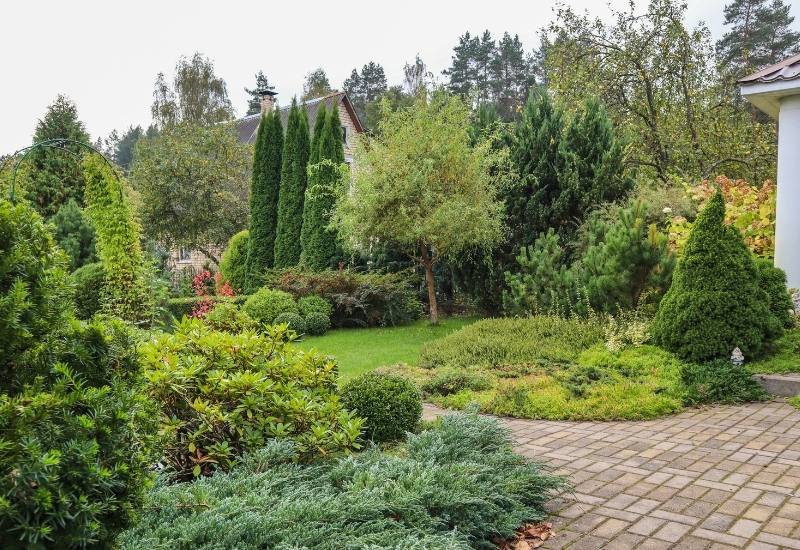
There are dwarf exotic trees, dwarf conifers, dwarf flowering varieties and even dwarf fruiting beauties that you can have for your garden.
Whatever the style you choose for your green space, you can landscape with grand ideas and bold looks even if on a miniature scale!

Written By
Adriano Bulla
After many years as an academic in London, Adriano Bulla became a writer, publishing books like A History of Gardening, Organic Gardening and Elements of Garden Design; he then decided to become a gardener, following his childhood dream, and has been following his dream writing and gardening professionally in Southern Europe, where he has specialized in new and innovative organic gardening fields and techniques, like permaculture, regenerative agriculture, food forests and hydroponics.
